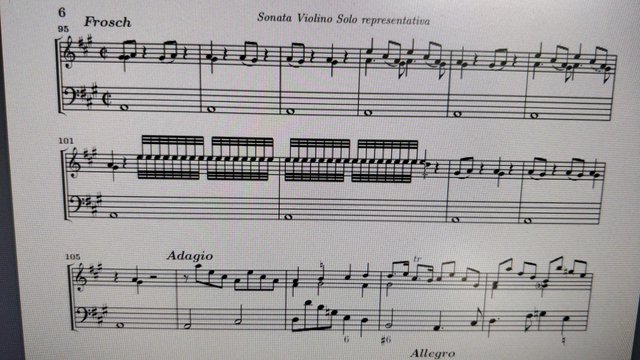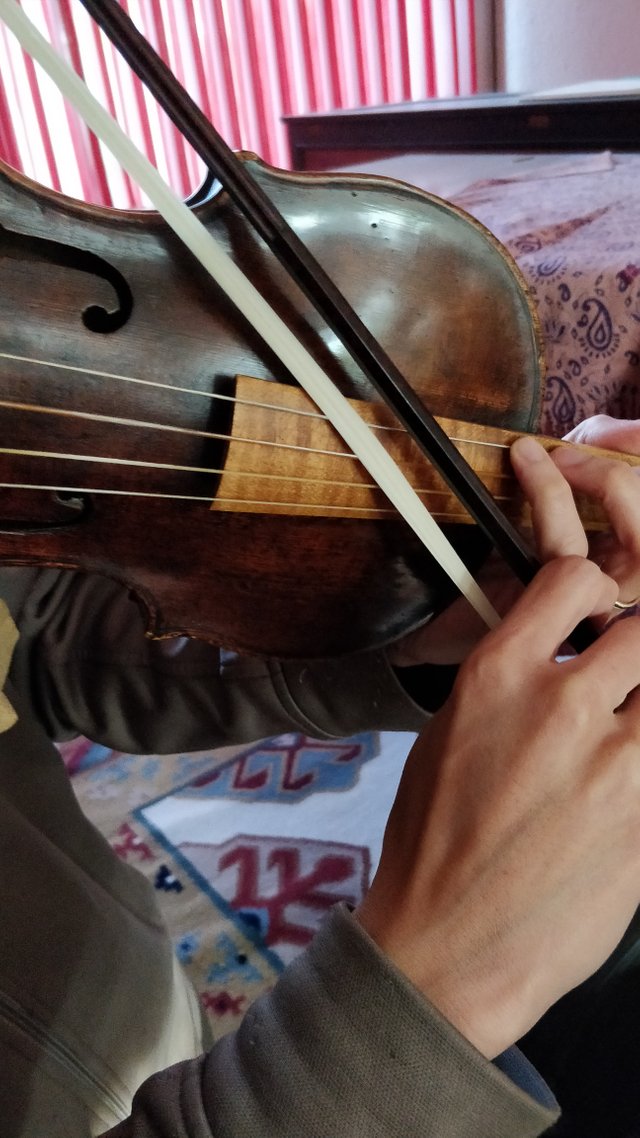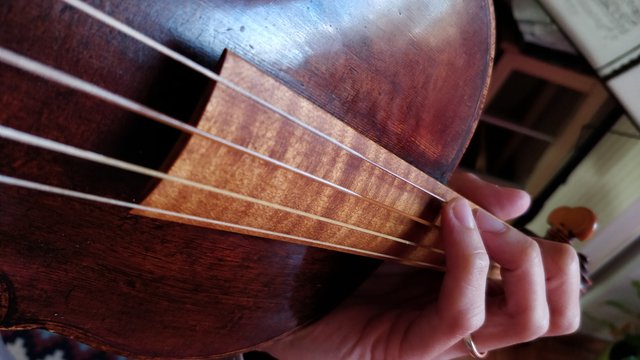How to make a violin sound like a frog! (IFC S02R05)

So, this week's @ifc (Information Finding Championship run by @apolymask) topic is a free choice topic! So, I took the opportunity to write about something that I've had on my mind for quite some time now.

The Animal Sonata!

There is a little piece in my repertoire of violin showpieces (little tasty treats that I can bring out at short notice!) that goes by the name, Sonata Representiva by the Baroque composer Heinrich Ignaz Franz Biber. The Baroque time was an interesting time in the development of music (and the part that I specialise in), as it was a time of improvisation and experimentation. One of the things that was quite popular at the time was the imitation of various sounds by musicians (on their instruments!). Examples of things that were imitated were Battles, stutterers and various nature sounds.
The Sonata Representiva (you can find the music here is a great little piece with imitations of various birds like the nightingale, cuckoo, quails, roosters and hens. In addition, there are various imitations of cats, musketeers and frogs!
My favourite one of these is the frog... if you get this right, then it is a complete surprise to the audience. In fact, the first time I play this with other musicians, they are also completely taken off guard!
Needless to say, the way that you write these imitations down as musical notation is quite imprecise... and thus, you really need to be quite imaginative in your technique and performance to get the right sounds across! Unfortunately, most of our modern music training is geared AWAY from experimentation from what would be considered "ugly" sounds, and so you can find many many performances of this sonata, where the "frog" doesn't sound like a frog at all!
Here is an example of what most performances of the "frog" will sound like:

My Frog!
Yep... at some point in time, I lost my fear... and embraced the fact that if you really want to sound like a frog on a violin, then you really need to make it work. This takes a bit of re-investigating the technique that you use to play the violin. Now, normally for a "normal" violin sound you would want to be having the bow touch the strings in the playing area as shown the in the photo below:

... the bow is relatively parallel to the bridge (or at right angles to the strings), and a balance of weight, speed, tilt and contact point all contribute to the different colours of sound that you want to produce. In the regular course of playing, the balance of these four ingredients are such that you can push the limits of what a violin "should" sound like, but you tend not to break through the boundary otherwise you are considered to be a bad or beginner player.
However, a frog sound is not the normal violin sound! Thus, we need to re investigate the way that we play the violin... and how we balance the four contributing factors that go into making the sound from the instrument.
To create a really raspy sound, we are going to have to completely throw these four ingredients out of balance (or as I prefer, into a NEW balance that is appropriate for the sound that we want!). This means that my bow starts to look like this:
.jpg)
... as you can see, the contact point (where the bow touches the string) is completely in the non-traditional playing part of the violin! A string will normally have it's greatest point of vibration in the centre of the string, so by having the bow touch near this point... I'm preventing it from resonating in a standing pattern. Thus making a rasping sound.
I also use a weight (pressure) that is much too heavy for what the string normally would support (for a good sound), this has the effect of "choking" the violin... something that you normally want to avoid, but is really useful for this situation. Flat tilt of the bow hair increases the footprint of the bow on the string, further hampering the natural resonance. Lastly, the angle of bow (the angle with the string) is partly defined by the shape of the violin, but is also chosen to help keep the bow stationary on the contact point with the string (an angled bow means that depending on if you are bowing up or down, there is a force towards the bridge or away from the bridge, a non-angled bow should give no push in either direction).
Lastly, there is a little trick that I play with the left hand (fingering...) which is suggested by the notes that Biber originally wrote.
.jpg)
This is to not touch the string fully down to the fingerboard (the instrument), but instead touch them softly to damp any "musical note" that might still try to escape despite the best efforts of the bow hand! By touching the string softly in a non-harmonic (not a simple ratio division of the string... so not half, third, quarter...) ratio, it prevents the string speaking normally. The choice of a non-harmonic is to disallow the formation of a standing wave (harmonic) that would correspond the simple ratio division of the string. (Keep in mind, we want frog, not music note!).
So, there you have my impression of a frog on a violin... and the thoughts that went into creating it! Apologies for the bad sound recording (and the toddler..) and the funny angle photos... it was all done on a phone... and it is quite hard to take a photo of a violin whilst holding it! Anyway, these were just a small sample of the possible sounds that I would be using... when I'm preparing the piece for a concert, I will have had a bit more time to experiment and rediscover the things that work!

On a side note...
One interesting thing that I've learnt in the reactions from the audience and fellow musicians when I perform this piece.. is how far music (also popular) has fallen from the concept of audio entertainment. In the Classical fields (and contemporary pop/rock...)., there is now a heavier emphasis on the LOOK of the performance rather than the SOUND of the performance. In fact, you can see that bias already here on Steem...
In the Classical Field (and modern music)... there has been a training to produce the "perfect" and flawless sound (this is greatly in part due to the concept of recordings...), and this has led to generations of risk-adverse performers. Performers who will rather take the safe road rather than the risky one.... To me, this is not music!
This little section of such a relatively fun piece shows how far this has gone. The concept of making these "frog" sounds are so alien to many of my colleagues... and this is in a piece that gives you complete license to make this UGLY sounds! However, a quick search (and the shocked reactions from some colleagues...) show that most musicians won't be brave enough to do it... it is a sad thing, when a piece that is meant as a funny showcase for making tricks on the violin is taken so seriously that a musician can't throw aside their fear of judgement and make a horrible sound!

Account banner by jimramones




.gif)
The classical music community at #classical-music and Discord.
Follow our community accounts @classical-music and @classical-radio.
Follow our curation trail (classical-radio) at SteemAuto
Community Logo by ivan.atman
Radio logo by plushzilla
Follow this account for classical music themed competitions, resteems from our contributors and general news and support from our community at #classical-music. Our Curation trail is over at https://steemauto.com/
Delegation links: 10SP, 25SP, 50SP, 75SP, 100SP, 150SP, 200SP, 250SP, 500SP, 1000SP
That was an incredible explanation of recreating a sound. It kind of reminds me taking a guitar pick and slowly grinding it up the length of the top E string. I think I will have to practice the frog rattle.
It's very similar to that! It's also just about finding interesting new things to do on the instrument! Mostly not good things, but useful for that one time you need the effect!
You should do sheep sounds for all the sheepish scared to experiment people.LoL.
Ha ha... Hmmm, a sheepl would be tricky! I would have to think hard about how to do that!
This is @bengy at his best! Bringing us something interesting, entertaining and challenging all at the same time :) Now I have a little challenge for my violinist friends (hehehe)...
Haha... torture your violin friends! I love it! Long time no see old Steem friend!
I think too many of us humans take life and work too seriously. Love that you're showcasing this fun and unconventional bit, showing that even something as refined as a violin can be used to be silly and create sounds that mimic nature. :)
Let's hope he confines himself to emulating frogs. Don't let your imagination wander. Or his either.
Heh?
It was an older notion, when the violin (and "Classical" music in general, wasn't the "refined" art that we now take it to be! Anyway, finding interest and joy is a great way to try and keep the creative interest alive!
ahahahahahahaha common, you did not just DO THAT! :D That is amazing, your daughter in the background seems to enjoy it too. lolololol, when I read the title I was thinking "ooh, he is not going to..." and then I heard and you completely blew my mind! :D
It's always a funny first impression on a new audience! I think my child was also a bit surprised as well!
How amazing, I never even realised a violin could sound anything other then...a violin! But your description makes perfect sense - when you treat the instrument in a different way how it sounds will change - musicians always fascinate me you have to know so much to even create a single note - and then even more to change it how you want.
#thealliance #witness
Sometimes our instinct about what is correct or expected is a good thing to have, other times it is a limitation to our imagination. In this case, it is definitely the latter, but it can be difficult to be brave enough to break the rules of good sound!
That sounds SO like a frog - your toddler was clearly impressed! But the "fake frog" is just pathetic! I love hearing surprising animal noises in music.
Yes, the fake frog is pretty lame... But so many people do it like that... Just because that is technically what is written in the score. But anyone can tell that that isn't quite right!
Hahaa! This is brilliant, and it does sound like a frog. Nice little tutorial here.
Do you have other violin tutorials? I am slowly learning (very slowly) as I can't find a teacher where I live. Some youtube videos are also hard to connect with...
Haha... after that you ask for tutorials!
No... I find that teaching violin over video or online is a bit of difficult problem... I find that teaching in person is the best way, there are just so many little things that need a direct physical hand to show.
It's what I thought and I know it's what I need, unfortunately I don't have that option. Oh well, I will take what I can get through internet and books. ^_^
Good luck! If you have specific questions... you know where to find me!
way cool can you do bull frogs?
Don't know! I will have to listen to a few audio tracks of BullFrogs!